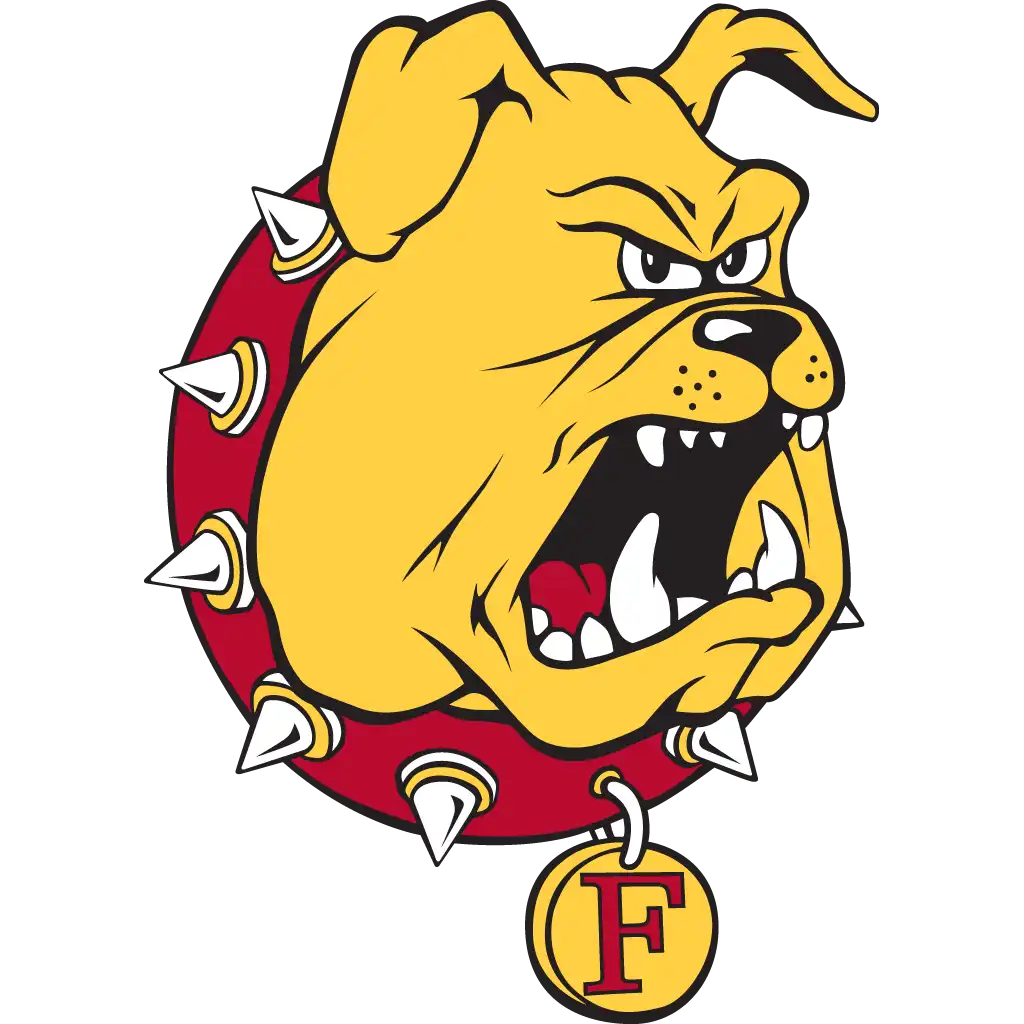By 1980 Ferris State's athletic programs had "grown up." After many years of fighting the athletic scholarship concept, Ferris began offering scholarships and tuition waivers to men and women athletes who qualified for intercollegiate athletic competition.
The first to get full scholarships was the varsity hockey team, which from its inception in the sports agenda at Ferris was self-supporting by way of admission charges to all. Later, other selected varsity teams received full scholarship support.
Through long-standing policy, all other athletic events were open without admission charge to students and faculty. Sometimes the stands were filled, sometimes they weren't, depending often on the quality of the teams.
Sometimes the stands were filled. Sometimes they weren't.
Unfortunately, just as the athletic programs shifted into high gear, the state's budget went into a critical slump, and all the athletic program restructuring had to be modified.
Development of the athletic programs from club activities to team activities began about the time the state took over the school. Before that everything had been sort of "hit and miss."
In the school's early days, athletics had been low priority. Although he believed in physical fitness, W.N. Ferris was not much for competitive sports -- probably because he didn't have time to play games when he was a boy. He had been too busy working the farm.
The Industrial had not been quite ready for intercollegiate athletics when those became traditions at the colleges and universities of the 1890's.
Nevertheless, the Institute was one of the first schools in the nation to teach "physical culture," as it was then called. When Ferris hired "Tommy" Carlisle, it was for the purpose of having him teach that discipline as well as elocution, and the 5-feet-2 Carlisle led exercise classes until he was in his eighties.
In the late twenties and early thirties, after Mr. Ferris' death, a semblance of athletic activity structure could be seen.
About all that happened at the Industrial until the mid 1920's in terms of group sports was that the Commercial students or the Pharmics got together a football team. Sometimes for lack of other competition they would play each other.
Mr. Ferris had an aversion to football. He thought it was horseplay, but he realized that it was a more wholesome activity than some others that the male students could engage in. When he saw a game in progress on or near the campus, he was likely to look the other way, and pretend he didn't notice. Gerrit Masselink on the other hand had been a champion wrestler in high school and at Michigan State College. When he saw a football game, he was likely to jump in and start playing or coaching, not conscious that he was wearing his "good" clothes.
The 1908 Crimson and Gold, the Institute's first yearbook, reported:
"While the Ferris Institute does not believe in making athletics the main subject of interest, it encourages manly sports and favors symmetrical development. In the fall, football furnished the attraction. Each department usually has a team, and the school as a whole supports a first and second team. During the past four years regular coaches have been employed.
Mr. Ferris thought football was horseplay.
 The old Ferris stadium nicknamed "stony field" for reasons obvious to those who played
on IT, was the focus of outdoor athletic competition at Ferris for many years. The
stands were built in the 1930's under Roosevelt's Work Progress Administration. It
was dismantled in the 50's to make way for campus development.
The old Ferris stadium nicknamed "stony field" for reasons obvious to those who played
on IT, was the focus of outdoor athletic competition at Ferris for many years. The
stands were built in the 1930's under Roosevelt's Work Progress Administration. It
was dismantled in the 50's to make way for campus development."In 1906 two games were played with Alma College. One resulted in a 0-0 score, and the other in a 4-0 score in favor of Alma. In 1907 Mt. Pleasant Normal (now Central Michigan University) was defeated by a score of 47-0, while the Kalamazoo Normal (now Western Michigan University) team held the Institute to a tie. Every other game was won by the Institute with the exception of the game with Alma.
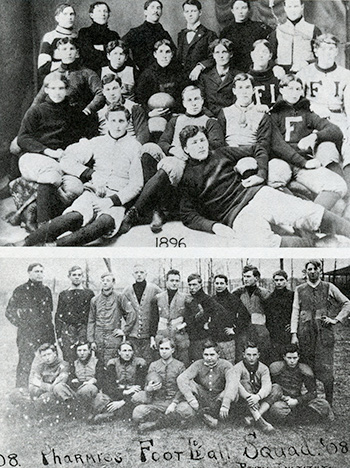 Football has long been a part of Ferris, in one form or another. The top photo shows
the 1896 varsity team. Some years there were such teams, and other years not. In 1908,
for example, the pharmics formed their own team to play games.
Football has long been a part of Ferris, in one form or another. The top photo shows
the 1896 varsity team. Some years there were such teams, and other years not. In 1908,
for example, the pharmics formed their own team to play games."During the winter, basketball teams were organized, and in the spring, baseball, tennis and track teams. The annual Field Day was held in June. This year 12 young men took part in the Inter-scholastic meet held at the M.A.C. (Michigan Agricultural College, now Michigan State University). The contests have always been clean and added much to the life of the school."
That first Crimson and Gold had its title page for athletics illustrated with pictures of a man in a baseball uniform and a woman in the traditional bloomers and middy blouse holding a basketball. Pictured in the section are the 1907 football team, the baseball team, two girls' basketball teams and the Big Rapids Tennis Club.
The 1910 yearbook said, "In reviewing the athletic history of the Ferris Institute, two factors must be kept in mind; the short term of the majority of students and the consequent lack of experience athletically which only continued seasons with the same players can eliminate."
This yearbook explained that after an unsatisfactory season in the fall of 1907, a regular Ferris Institute football team was abandoned. For the 1908 season no regular Ferris football team existed although each of the larger departments organized teams and played a series of games.
In 1910 Gideon Smith came to Ferris to take college preparatory work for Michigan State Agricultural College. The fact that he was a black apparently made no difference at Ferris, and Smith played football at the Institute for three years. In 1913 he went to Michigan State and almost immediately went out for the football team. The coaches at Michigan State wouldn't issue him a uniform, but Smith managed to get in the game in his street clothes.
After the coaches saw what he could do, Smith was suited up, becoming the first black football player at Michigan State.
In 1911 students organized a walking club.
Early in February 1911, some FI students decided to organize a walking club, similar to today's jogging clubs. About 80 students responded, and the group was organized in two divisions. The boys' division walked on Tuesday and Thursday evenings and on Saturday afternoons. The girls' division walked on Saturday forenoons.
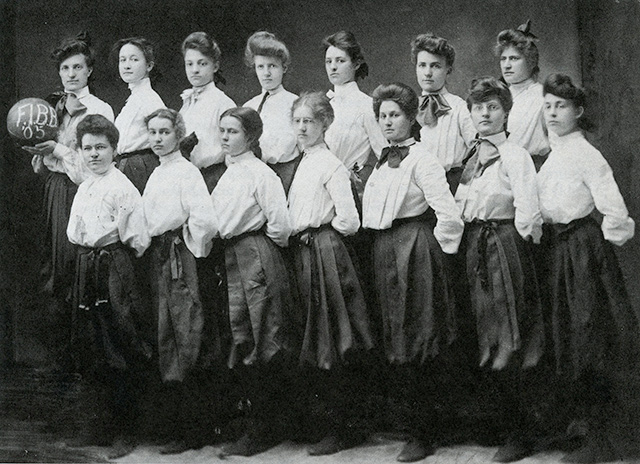 Female athletes are not new to the Ferris campus. Coach Mary McNerney, who developed
many championship teams,is at the far left in the first row.
Female athletes are not new to the Ferris campus. Coach Mary McNerney, who developed
many championship teams,is at the far left in the first row.By 1911 W.C. "Top" Taggart was playing on the football team and is credited with coaching that team. One campus story has it that Mr. Ferris hated to see the Taggart brothers ("Top" and James) come on campus because he knew it meant a football game.
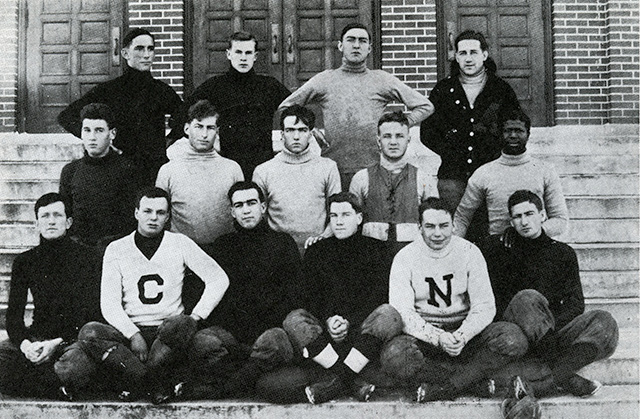 The legendary Top Taggart is third from left in the top row of this picture taken
from the 1912 Crimson and Gold. Other members of the team were Moore, Capt.; Reams, quarterback; Smith; Carter;
Baldwin; Rawden; Sonnenstrahl; Carlson; Gargett; Johnson; Sheppard, and Kelly. The
coach was Van Thorn and the manager, Mr. Masselink.
The legendary Top Taggart is third from left in the top row of this picture taken
from the 1912 Crimson and Gold. Other members of the team were Moore, Capt.; Reams, quarterback; Smith; Carter;
Baldwin; Rawden; Sonnenstrahl; Carlson; Gargett; Johnson; Sheppard, and Kelly. The
coach was Van Thorn and the manager, Mr. Masselink.In the early days of the state school, Top Taggart's contributions made possible the football stadium, which bears his name. He also was a benefactor to the college in many other ways, particularly in the buying of land and holding it for the college until it had the funds to purchase it.
In the century's second decade, girls' basketball probably was the most organized of all the campus sports. Mary McNerney was the coach, and she developed some championship teams during that period.
Like Finnegan, the athletic programs were on again, off again, especially football. Baseball seemed to be the only stable team.
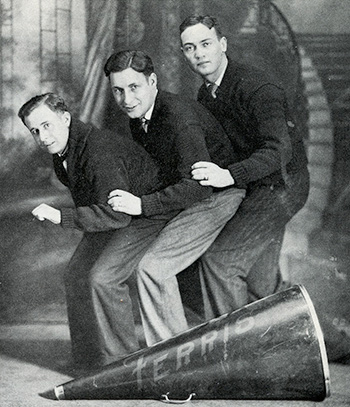 Like Finnegan, the athletics program was on again, off again.
Like Finnegan, the athletics program was on again, off again.By 1924, the Crimson and Gold was reporting:
"Athletics at Ferris Institute is now becoming established as part of the institution. Heretofore, competitive sports have had a rather desultory existence, but now, chiefly due to the activity of E.M. Clark and W.T. Hein, steps are being taken to place teams in the field to represent the school among other colleges of the state in three major sports: football, baseball and basketball.
"This year for the first time in the history of the school, a basketball team was placed in the field. The venture proved a great success from the standpoint of both victory and finances. The student body supported the team loyally. Never before has any team received such enthusiastic backing as during the recent basketball season. The team fulfilled every expectation and merited all the support the school could possibly give. The superiority of our team has been shown by its many victories, particularly during the final game of the season when it overwhelmed the Davenport Institute, one of its strongest opponents, by a large score . . . .
"Coach Hein will receive special instruction in football, coaching this coming summer under Fielding H. Yost at Ann Arbor. Mr. Hein is already forming plans toward placing a winning football team on the gridiron next season . . . .
"Ferris Institute has always had a good baseball team. In past years it has defeated varsity teams from many of the larger colleges . . . .
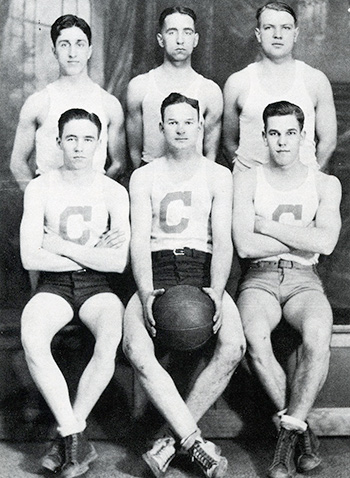 Even as late as 1928, the Institute's academic departments sometimes supported their
own athletic teams. This is the 1928 Commercial basketball team. The last names of
the members are: Braendle, Williams, Rundquist, Van Alstine, Brass, Friedly, Horan
and Tamblin.
Even as late as 1928, the Institute's academic departments sometimes supported their
own athletic teams. This is the 1928 Commercial basketball team. The last names of
the members are: Braendle, Williams, Rundquist, Van Alstine, Brass, Friedly, Horan
and Tamblin."Plans are underway for a large gymnasium (the Alumni Building). This will foster an interest in athletics more than anything else. Action along this line is eagerly watched by the student body. At present the National Guard Armory [which occupied a space next to Big Rapids' City Hall] serves as the school gym. But we want a gymnasium of our own. Hasten the day . . . ."
In 1927 Bill McElwain, who had been a star halfback at Northwestern University and a professional player for the Chicago Bears with Red Grange, came to Ferris to coach football and become the school's athletic director.
In 1929 the new gymnasium was dedicated with the Alumni Building which housed it.
By 1931 things were looking up in football. Harvey Long, a coach at Loyola University and former star player for the University of Detroit, was hired as Ferris line coach.
It was during the 30's that the "Bulldogs" became the nickname for the Ferris teams, following a season when McElwain's basketball team hung on so tenaciously during the games that a sports writer drew the comparison between it and that particular breed of canine.
McElwain took a leave of absence in 1935 to pursue a law degree, but returned to coach in the fall of 1936. He stayed at the helm of athletics until 1940 when he had a disagreement with then President Ward.
McElwain later became a successful attorney in Big Rapids, numbering among his clients the Taggart brothers.
In 1947 the athletic programs began to grow. Frank Karas joined the staff to assist Bob Sherman, who the year before had by himself handled all the athletic direction and coaching. But it was not until 1953 that the school was "on its feet" enough to consider a full-fledged athletic program.
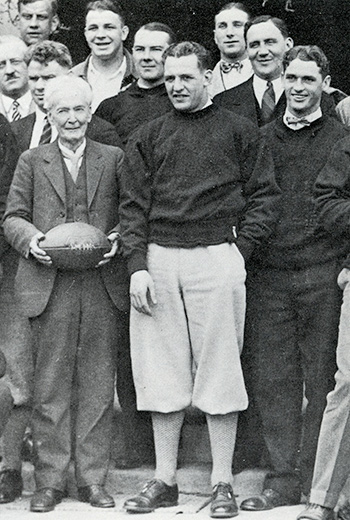 Bill McElwain, at right, was a coach and teacher at Ferris for Many years, He later
was a Big Rapids lawyer. But before all that, he was a star halfback at Northwestern
and a member of the Chicago Bears professional football team along with teammate Red
Grange. On one of the team's trips, its members posed with biologist Luther Burbank
(left) and Grange (center).
Bill McElwain, at right, was a coach and teacher at Ferris for Many years, He later
was a Big Rapids lawyer. But before all that, he was a star halfback at Northwestern
and a member of the Chicago Bears professional football team along with teammate Red
Grange. On one of the team's trips, its members posed with biologist Luther Burbank
(left) and Grange (center).Mr. Ferris had not been interested in athletics, and the presidents who succeeded him had terms too brief to take any kind of stand on varsity sports. But President Victor Spathelf had been a track star at Wayne State University and had maintained a keen interest in athletics.
He also had a clear view of how he wanted the athletic programs developed. He did not want Ferris to become a one-sport school, and he was adamant in his refusal to develop an athletic scholarship program.

In the 1960's when there was much debate about the extravagances of athletic scholarships, there was some talk about discontinuing these scholarships in the major schools. At this point Ferris was ready to jump in and say: "We've been doing it for years." But nothing came of the idea.
In 1953 Sam Ketchman came to Ferris to begin structuring a definitive varsity athletic program. Frank Karas continued as his assistant.
Meanwhile "Stony Field," where the players got more bruises from the gravel than from the opposing team, was dismantled to make room for Ferris buildings. Ferris played its football games on the old high school field until Top Taggart Field was opened in the fall of 1957. (When Big Rapids High School abandoned its football field, its team played at Top Taggart Field.)
Ketchman said later the most exciting football game he ever coached was in 1964 when Ferris played Indiana Central.
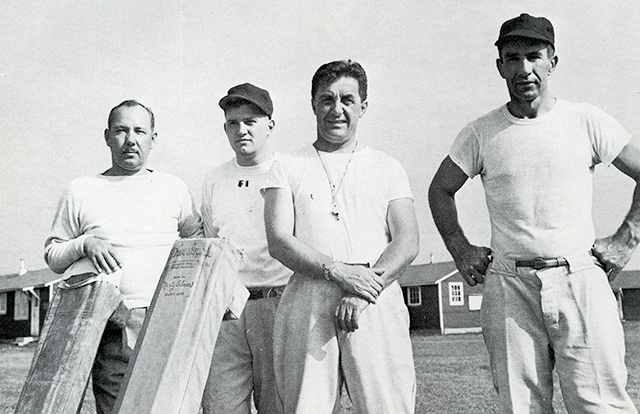
Indiana Central was undefeated 7-0 in the Indiana Collegiate League and had as a player Dick Nyers, the leading scorer in all the colleges in Indiana that year, including Notre Dame, Purdue and Indiana University. Nyers later played a year or two with the Baltimore Colts.
 Corey Bouyer, Ferris' "Greatest Athlete."
Corey Bouyer, Ferris' "Greatest Athlete."
Ferris went into the game as definite underdogs with a record of 3 wins, 1 loss and 1 tie.
The Indianapolis newspapers referred to Ferris as a "bunch of bushers" from the country in Central Michigan, and picked Ferris to lose by at least four touchdowns.
But the Bulldogs won the game 12-0, spoiled the Indiana team's great record and held Dick Nyers to a total of about 25 yards for the entire game.
Not too long after Sam Ketchman arrived on the scene to head the football program, Jim Wink arrived to lead the basketball program.
In Wink's first 20 years as basketball coach -he arrived on campus in 1959 -- the team went to the national NAIA tournament in Kansas City five times -- 1960, 1962, 1964, 1973 and 1975. Health problems forced Wink to retire from coaching during the 1980-81 season, but not before he accumulated a 326-175 career record.
By the early 1960's the Alumni gymnasium which had been such a source of pride in 1929, was outdated, outmoded, and entirely too small.
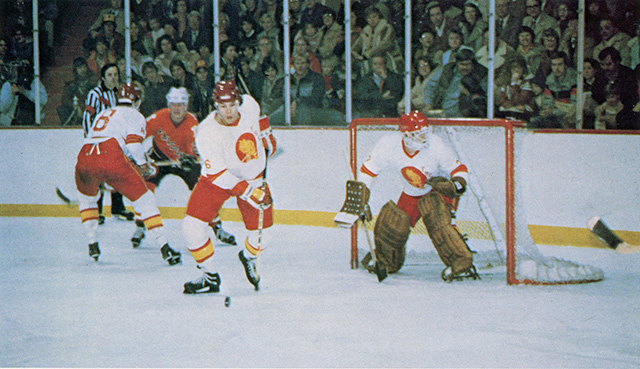 The old gym had to serve physical education classes for women as well as for men and
for varsity and intramural sports.
The old gym had to serve physical education classes for women as well as for men and
for varsity and intramural sports.
The locker rooms were too small and were located an inconvenient distance from the football stadium.
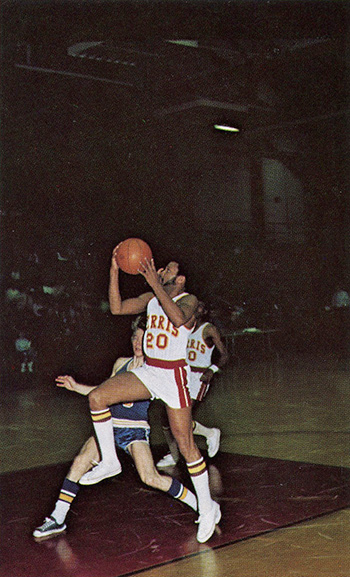 Between 1959 and 1981 the basketball team went to the NAIA tournament in Kansas City
five times.
Between 1959 and 1981 the basketball team went to the NAIA tournament in Kansas City
five times.A concerted effort was soon made to acquire a new facility which would serve indoor athletic sports, health and physical education classes and recreation. That drive resulted in the present Health and Physical Education Building dedicated in 1963.
The new building had a 25-yard swimming pool, and within a few years a swimming team was formed. The new building could also accommodate indoor track, extending that season several months. Varsity wrestling also made its debut.
In the 70's President Robert Ewigleben, who later had a son on the FSC cross country and track teams, was as keenly interest in athletics as was President Spathelf. He began to enhance the athletic programs in many ways.
Finding teams to compete within the region was somewhat of a problem. Some of the institutions nearby wanted to play in the big leagues, and others were too limited in their scope of talent to play "big" Ferris. Ferris spearheaded the formation of the Great Lakes Intercollegiate Athletic Conference in the early 70's, giving Ferris a group of regional teams to meet in athletic competition.
By 1972 the college launched a comprehensive program of intercollegiate athletics for women.
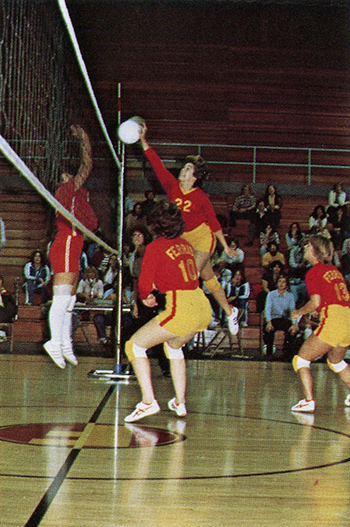 Women's varsity sports enjoyed a boom near the end of the College's first century,
with teams entered in league competition in such sports as softball, basketball and
volleyball.
Women's varsity sports enjoyed a boom near the end of the College's first century,
with teams entered in league competition in such sports as softball, basketball and
volleyball.In the 1970's Ferris State College still had a reputation of being a "suitcase college," a term meaning that many students went home on weekends. The practice began in the late 40's and 50's when the students went home to work weekend jobs, which for the most part paid for their education. But even though the Student Center Board tried to provide some sort of activity each weekend for the students, many of them thought there wasn't anything to do at Ferris or in Big Rapids over the weekend and consistently left campus each Friday.
Ewigleben felt that the students needed more recreational facilities than the gymnasiums could give them, and plans were initiated for an 18-hole golf course and an ice arena. The golf course was subsidized by a gift from Mr. and Mrs. Marvin L. Katke. Katke, a friend of Ferris and a Mecosta County native, was vice president for manufacturing of the Ford Motor Company and a,,1967 recipient of an honorary degree from the college. In a decade Mr. and Mrs. Katke had given approximately $185,000 for campus development, enough for the first phase of the golf course.
Of course, the Katke course provided a location for the varsity golf matches. Previously these matches had been held at a private club some distance from campus. The golf course also provided a facility necessary for the Professional Golf Management program, a unique baccalaureate degree curriculum offered by the School of Business.
The Ice Arena, which was to be self-liquidating, brought a new dimension to varsity athletics -- an intercollegiate hockey team. A member of the Central Collegiate Hockey Association, the Ferris team soon began competition with many top regional universities, and became (in 1980) Ferris State's only NCAA Division I-affiliated sport.
 Construction of the Ice Arena was a campus milestone.
Construction of the Ice Arena was a campus milestone.From 1963 to 1980 Ferris Bulldog teams turned out 26 All-Americans. Five of them -- Chuck Evans, football; Tony Fleming, track; Terry Kirkpatrick, baseball; Doug Gillard, track; and Corey Bouyer, track, were two time winners. Evans and Bouyer, perhaps, were the most noteworthy. Evans, a 5-feet-9, 170-pound halfback, led the NCAA Division III in rushing in 1976. Previously, Ferris sports also pointed with particular pride to Bouyer, the 1970 NAIA national champion in the 440-yard intermediate hurdles. Ferris' first female All-American, high jumper Rhonda Filius, was honored in 1981.
Several significant accomplishments in modern Ferris athletic history revolved around, among others, the football, softball, cross country, golf and hockey teams.
Ferris State's first, and only, undefeated football season came under Bob Leach's direction in 1968. The Bulldogs rolled to a 7-0-1 record, including a 29-28 trimming of Illinois State in the season finale.
The 1980 Ferris softball team accounted for the College's first women's team to appear in national competition. Coached by Monica Folske, Ferris posted a 26-8 record and placed fifth in the AIAW Division II National Championships in Sacramento, California.
Cross country, under Coach Ray Helsing, captured Ferris' highest national finish placing fourth in the NCAA Division II in 1980, while the men's golf team was building a dynasty in the Great Lakes Conference. Under the direction of Jim Wink and later Ron English, the Bulldogs took four league links crowns in the years beginning in 1977.
I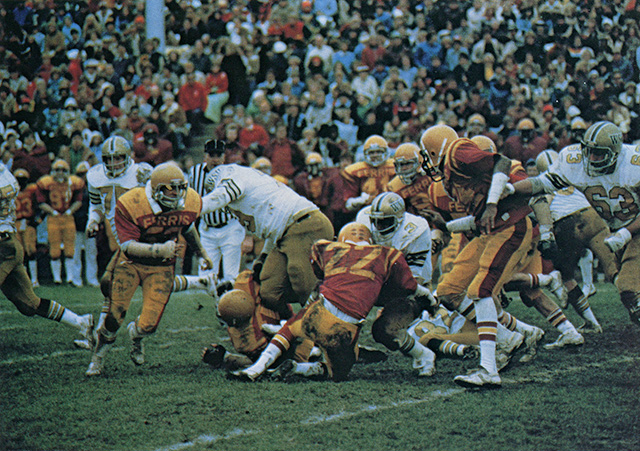 ce hockey vaulted Ferris into national prominence during the 1979-80 season. Competing
in its first year in the Central Collegiate Hockey Association, an NCAA Division I
league, Rick Duffet's team upset heavily favored Ohio State in the league playoffs
and advanced to the playoff finals against Northern Michigan.
ce hockey vaulted Ferris into national prominence during the 1979-80 season. Competing
in its first year in the Central Collegiate Hockey Association, an NCAA Division I
league, Rick Duffet's team upset heavily favored Ohio State in the league playoffs
and advanced to the playoff finals against Northern Michigan.
Then, at the conclusion of the 1980-81 sports year, for the first time Ferris won a share of the President's Cup, symbolic of all-sports supremacy in the Great Lakes Conference. Ferris State College athletics had come a long way since the days when the school's founder expressed concern for so-called "horseplay."
| Previous | Next |
